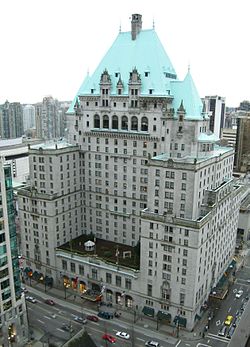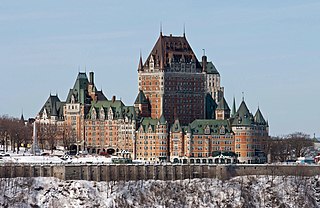
The Fairmont Le Château Frontenac, commonly referred to as the Château Frontenac, is a historic hotel in Quebec City, Quebec, Canada. The hotel is situated in Old Quebec, within the historic district's Upper Town, on the southern side of Place d'Armes. The Château Frontenac was designed by Bruce Price, and was built by the Canadian Pacific Railway company. The hotel is managed by Fairmont Hotels and Resorts.

The West End is a neighbourhood in Vancouver, British Columbia, Canada, located between the Coal Harbour neighbourhood and the financial and central business districts of Downtown Vancouver to the east, Stanley Park to the northwest, the English Bay to the west, and Kitsilano to the southwest across the False Creek opening.

Canadian Pacific Hotels (CPH) was a division of the Canadian Pacific Railway (CPR) that primarily operated hotels across Canada. CPR restructured the division as a subsidiary in 1963.
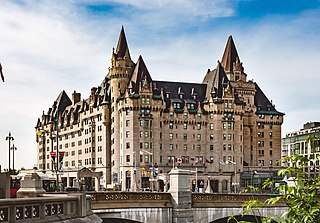
The Fairmont Château Laurier is a 660,000-square-foot (61,000 m2) hotel with 429 guest rooms in the downtown core of Ottawa, Ontario, Canada, located near the intersection of Rideau Street and Sussex Drive and designed in a French Gothic Revival Châteauesque style to complement the adjacent Parliament buildings. The hotel is above the Colonel By Valley, home of the Ottawa Locks of the Rideau Canal, and overlooks the Ottawa River. The main dining room overlooks Major's Hill Park. The reception rooms include the Wedgewood-blue Adam Room; the Laurier Room defined by Roman columns; the Empire-style ballroom and the Drawing Room featuring cream and gold plaster ornament. The hotel was designated a national historic site in 1980.

Waterfront station is a major intermodal public transportation facility and the main transit terminus in Vancouver, British Columbia, Canada. It is located on West Cordova Street in Downtown Vancouver, between Granville and Seymour Street. The station is also accessible via two other street-level entrances, one on Howe Street to the west for direct access to the Expo Line and another on Granville Street to the south for direct access to the Canada Line.
Fairmont Hotels & Resorts is a global chain of luxury hotels that operates more than 70 properties worldwide, with a strong presence in Canada.

The Fairmont Royal York, formerly and still commonly known as the Royal York, is a large historic luxury hotel in Toronto, Ontario, Canada. Located along Front Street West, the hotel is situated at the southern end of the Financial District, in Downtown Toronto. The Royal York was designed by Ross and Macdonald, in association with Sproatt and Rolph, and built by the Canadian Pacific Railway company. The hotel is currently managed by Fairmont Hotels and Resorts.

The Fairmont Banff Springs, formerly and commonly known as the Banff Springs Hotel, is a historic hotel located in Banff, Alberta, Canada. The entire town including the hotel, is situated in Banff National Park, a national park managed by Parks Canada. The hotel overlooks a valley towards Mount Rundle, both of which are situated within the Rocky Mountain mountain range. The hotel is located at an altitude of 1,414 metres (4,639 ft).

The Fairmont Hotel Macdonald, formerly and commonly known as the Hotel Macdonald, is a large historic luxury hotel in Edmonton, Alberta, Canada. Located along 100 Street NW, south of Jasper Avenue, the hotel is situated in the eastern end of downtown Edmonton, and overlooks the North Saskatchewan River. The 47.7-metre-high (156 ft) hotel building was designed by Ross and MacFarlene and contains eleven floors. The hotel is named for the first prime minister of Canada, Sir John A. Macdonald.
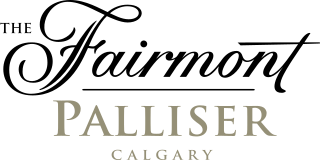
The Fairmont Palliser, formerly known as the Palliser Hotel, is a hotel of the Canada-based Fairmont Hotels and Resorts chain. The historic hotel (1914) is located in downtown Calgary, Alberta, at 133 9 Avenue SW adjacent to the Calgary Tower and Palliser Square. The Palliser is one of Calgary's oldest and most luxurious hotels.

The Burrard Street Bridge is a four-lane, Art Deco style, steel truss bridge constructed in 1930–1932 in Vancouver, British Columbia, Canada. The high, five part bridge on four piers spans False Creek, connecting downtown Vancouver with Kitsilano via connections to Burrard Street on both ends. It is one of three bridges crossing False Creek. The other two bridges are the Granville Bridge, three blocks or 0.5 km (0.31 mi) to the southeast, and the Cambie Street Bridge, about 11 blocks or 2 km (1.2 mi) to the east. In addition to the vehicle deck, the Burrard Bridge has 2.6 m wide sidewalks and a dedicated cycling lanes on both sides.
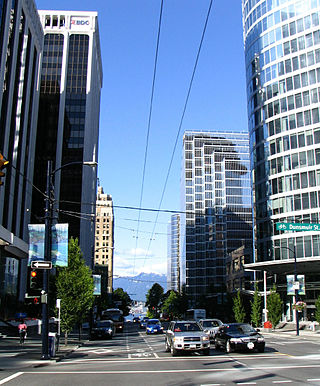
Burrard Street is a major thoroughfare in Vancouver, British Columbia, Canada. It is the central street of Downtown Vancouver and the Financial District. The street is named for Burrard Inlet, located at its northern terminus, which in turn is named for Sir Harry Burrard-Neale.

The Fairmont Empress, formerly and commonly referred to as The Empress, is one of the oldest hotels in Victoria, British Columbia, Canada. Located on 721 Government Street, it is situated in Downtown Victoria, facing the city's Inner Harbour. The hotel was designed by Francis Rattenbury, and was built by Canadian Pacific Hotels, a division of the Canadian Pacific Railway company. The hotel is presently managed by Fairmont Hotels and Resorts, part of AccorHotels since 2016. It is owned by Nat and Flora Bosa of Vancouver.

The Delta Hotels Bessborough, formerly and commonly known as the Bessborough, is a historic hotel in Saskatoon, Saskatchewan, Canada. The hotel is within the Central Business District, a commercial district in Saskatoon. The Bessborough was designed by Archibald and Schofield for Canadian National Hotels, a division of Canadian National Railway.

The Fairmont Le Château Montebello, formerly and commonly known as the Château Montebello, is a historic hotel and resort complex in Montebello, Quebec, Canada. The resort complex includes a large game reserve and a large wooden structure. The wooden hotel structure was developed by Victor Nymark.

Canada's grand railway hotels are a series of railway hotels across the country, each a local and national landmark, and most of which are icons of Canadian history and architecture; some are considered to be the grand hotels of the British Empire. Each hotel was originally built by the Canadian railway companies, or the railways acted as a catalyst for the hotel's construction. The hotels were designed to serve the passengers of the country's then expanding rail network and they celebrated rail travel in style.
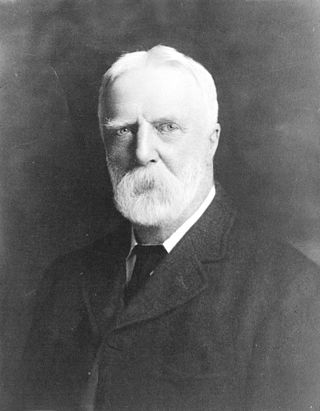
Henry John Cambie was a Canadian surveyor and civil engineer and a notable figure in the completion of Canada's transcontinental railway. He was also a notable pioneer resident of Vancouver.

The Financial District is a highrise office commercial area within the central business district of Vancouver, British Columbia, Canada. Located roughly along Burrard and West Georgia Streets on the Downtown Peninsula, the Financial District contains more than 60% of Greater Vancouver's office space, and is home to headquarters of forest products and mining companies. The area contains numerous federal and non-governmental organizations (NGO) offices, overseas missions and consulates, and headquarter and branch offices of national and international banks and financial services, accounting and law firms, and luxury hotels.

Fairmont Pacific Rim is an upscale hotel and condominium building in Vancouver, British Columbia. It stands at 140 m or 44 stories tall and was completed just prior to the 2010 Winter Olympics on February 4, 2010.
